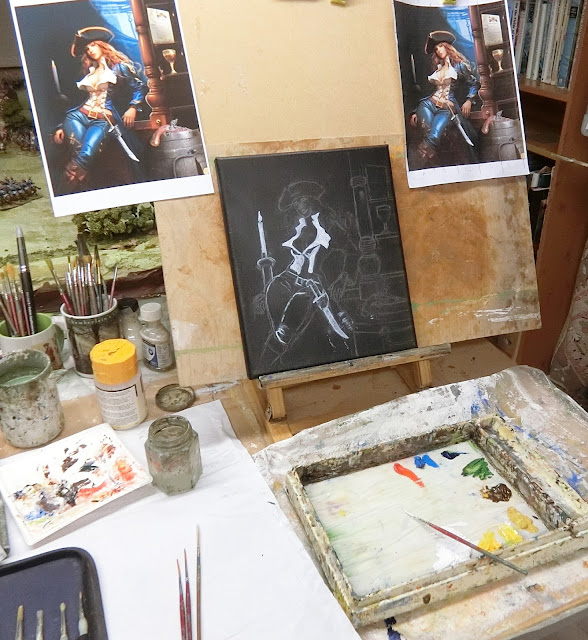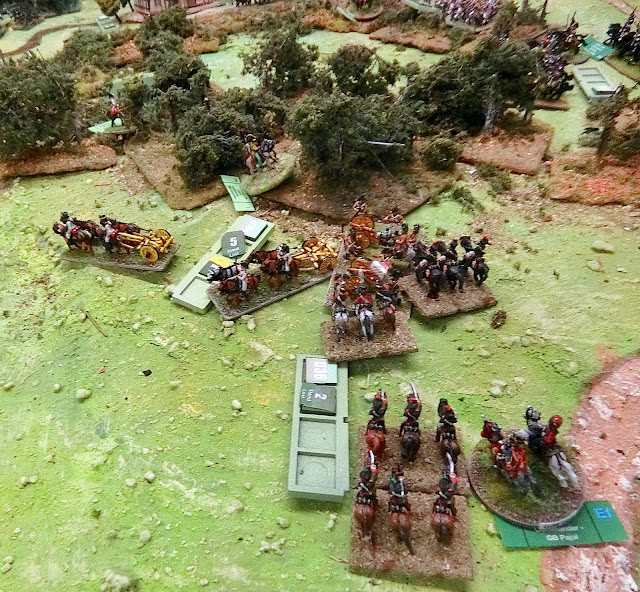When he started down the rocky road as a professional artist Sir Joshua Gregg RA never imagined he would have to sneak into an enemy country, in disguise, to further his obsession to paint beautiful, exotic and dangerous women!
There is not much documentary evidence for this exploit as Sir Josh gave little away in his memoirs, for reasons which will become clear following such research as I have been able to do. In 1780, when Sir Josh was in his mid 50s news, one might say only rumour, was spreading throughout London of a French Corsair causing havoc in The Channel among British merchant shipping taking supplies to the beleaguered British and Hessian troops in the American colonies. This brig was said to be "womaned" by an entirely female crew and led by a young, beautiful and ruthless daughter of a French aristocrat. Working outside the regular naval authorities, yet within the law under her "Lettre de Marque", signed by King Louis personally, this Capitaine, known only as Julienne, had evidently developed a unique method of parting the merchant crews from their precious cargoes.
 |
| Julienne - and Sir Joshua has depicted her Lettre de Marque pinned up for all on board to see |
Delving deep into archives of private letters and promissory notes, sometimes in dusty basements of English Historic Houses, one can piece together snippets of information from landed gentry, shipping magnates, senior Government officials, Admiralty ledgers and even from merchant sea captains and a few educated junior officers. Reading "between the lines" of the tortuous 18th century flowery language this is how she did it.
Julienne herself and some of the more well endowed and younger crew members would hail the passing ships, making out they were in distress with a false rigging and sails appearing to have been fouled by a storm. The British sailors, unable to resist the beautiful French accents and obvious physical charms, having been at sea for at least a week, maybe two, went on board to help. Only then were cutlasses and pistols drawn and the, shall we say, well worn and more mature crew members then in evidence bearing these arms. But violence was not top of the agenda. Julienne's aim was to wreck the British trade by acquiring all these goods for her crew and for France. Rather she invited the merchant crews on board to "Party" in exchange for their cargoes - with the alternative as a watery grave......
Not surprisingly it was, as we say in the 21st Century, "a no-brainer" to enjoy the delights on board "La Dauphine Amusante" and write-off the cargoes as "washed overboard in a storm". The shipping owners could claim the insurance and surely the War in the Colonies would be won by the time Lloyds of London smelled a rat.
Once a journalist's take on this scandalous story made "The London Times" it became a hot topic of conversation in the coffee lounge of the Royal Academy in Piccadilly. As one of the RA's most trusted and long serving members Sir Josh was well placed with contacts among the Lords Commissioner of the Admiralty to arrange for him to be transported to France as "a private citizen", supposedly to conduct secret negotiations with the French (This was long before MI6 of course!). How he explained all those trunks of canvases, brushes and paints and his travelling easel we shall never know. There were naturally sceptical and sanctimonious types who were ready to brand Sir Josh a traitor, and Art Historians have come to suspect that he may have had to bribe quite a lot of well-placed members of Society to keep things quiet. Looking at Sir Josh's life's work, and his early studies under that French reprobate artist, Francois Boucher, (see for example) it's not hard to imagine that, in the fullness of time, a number of sketches or paintings of other members of the crew will emerge. They will have been kept under lock and key by the hypocritical owners for fear of being denounced in Parliament or their Church! However, if any come up on TV's "Fake or Fortune", I for one will be avidly interested.
We can only guess that Sir Josh had managed to get a message ahead to convince Capitaine Julienne that this was not some British trick but a genuine effort to flatter her ego and satisfy his own curiosity. What else Sir Josh managed to satisfy of course he kept very quiet about! But we do know he was very fit and healthy for his age and an advocate of a non-meat diet, so who knows what he got up to when away from Lady Josh's oversight! For Josh, of course there was a professional motive. Once the War was over and the shame of giving up the American colonies died down, he was happy to exhibit "Capitaine Julienne" in the Royal Academy Members Exhibition of 1784. His fame took a boost and the commissions once again rolled in from the Great and Good of England. An excerpt from one historian's analysis gives an idea of how this notorious portrait drew even more acclaim than Sir Josh's "Prince of Wales" in the same year.
"However, his most admired work by far was his portrait of the French Corsairette Julienne in the guise of a sea captain. The painting attracted rapt reviews and was widely esteemed—as it still is today—to be one of Sir Joshua’s finest. Yet as the The Whitehall Evening-Post shrewdly observed, this triumph was due, at least in part, to the circumstances of its display. While noting that, “in the present Exhibition Sir Joshua stands so proudly pre-eminent,” the journal expressed “our regret, that Gainsborough should not have kept his ground.” Had he done so, it gamely wagered, “he would, doubtless, have shared the prize of publick applause with the President, and have afforded good ground for solid and substantial doubts, which of the two deserved the better half.”
As a fan of all these esteemed 18th Century portrait artists I remain strictly neutral! However one might speculate that some of Sir Josh's resultant commissions were from those secretly involved in his sojourn on the French coast in 1780, and needed a "cover" themselves.
>>>>>>>>>>>>>>>>>>>>>>>>>>>>>>>>>>>>>>>>>>>>>>>>>>>>>>>>>>>>>>>>>>>>>>>>
Well I hope you've enjoyed my little seasonal tale of Alternative History. For the more artistically minded you might find it interesting how my painting came about.
I've accumulated a lot of commissions during the early part of 2023 for paintings of ladies of various types - Fantasy in sheer dresses, Hussarettes and even 1860s/70s Zouavettes and by September I hired a professional model living not that far from me. We had two very long and productive sessions with about 8 major costume changes involving many uniforms and props and wigs and with indoor and outdoor settings. No doubt those who follow me on Instagram or my website will see the results in due course. For this one I started off with a couple of Hussarette photos which I thought promising and ran them through an Artificial Intelligence system called MidJourney.
AI for artists like me is a tortuous process and I'm still very much at an experimental stage. The AI system doesn't accept too much flesh on display so I had to "add" the blue breeches in Photoshop to fool it. But the point was that I did not know what to expect and one goes through many iterations, asking for variations and then getting multiple choices from which to proceed further. Here are some examples, not in progressive generation order though.
The one at bottom right looked reasonably "authentic" as something I could use in an 18th Century context and weave a story round. You will note from these examples that the AI seems to be pre-destined to give somewhat "steampunk" costumes and settings. It can't cope with a Napoleonic Hussar pelisse nor render a bicorne hat except as if the wearer is some kind of sailor or pirate.
Never mind, as a source for the fanaticism of Sir Joshua Gregg's brush it proved fruitful!
So I took that image and worked it up in the AI and Photoshop to the proportions I wanted for my canvas and added the candle, barrel, short sword, pistol, glass of wine, background enigmatic evening sky and "Lettre de marque" to provide the following reference from which to paint.
What follows are pics of a very condensed view of the process in realising the acrylic painting.
 |
| The painting area and the opening outlines based on pencil drawing |
 |
| White acrylic outline on black gesso ground gives me a very good starting point for colour |
 |
| The candle and distant background are the only parts complete so far |
 |
| Finishing the face early gives it character and encourages me to press on |
 |
| The figure is complete, now I just have to tidy up the mahogany shelving, barrel, wine glass and final tightening up. |
Here is the final painting
 |
| "Capitaine Julienne, Corsairette, 1780" (Nr 34 in the Hussarette Series) Acrylic on canvas, 12 inches x 10 inches |
 |
| Detail of cutlass and pistol |
"Julienne " is in my opinion a super painting and the actual article is a gem. Much better than any of the pictures here suggest. I hope one of by regular collectors may like it, or indeed if you want to start your collection of my "Hussarettes" what better than this one at under £100? Please email me if you are interested in discussing it. Chris Gregg
Here also is a link to my Art website - for Military Art, Hussarettes, Landscapes, Fantasy and Female figures Chris Gregg Art
I wish all my regulars and new visitors alike a Great Christmas and a really happy, healthy and successful 2024.























































